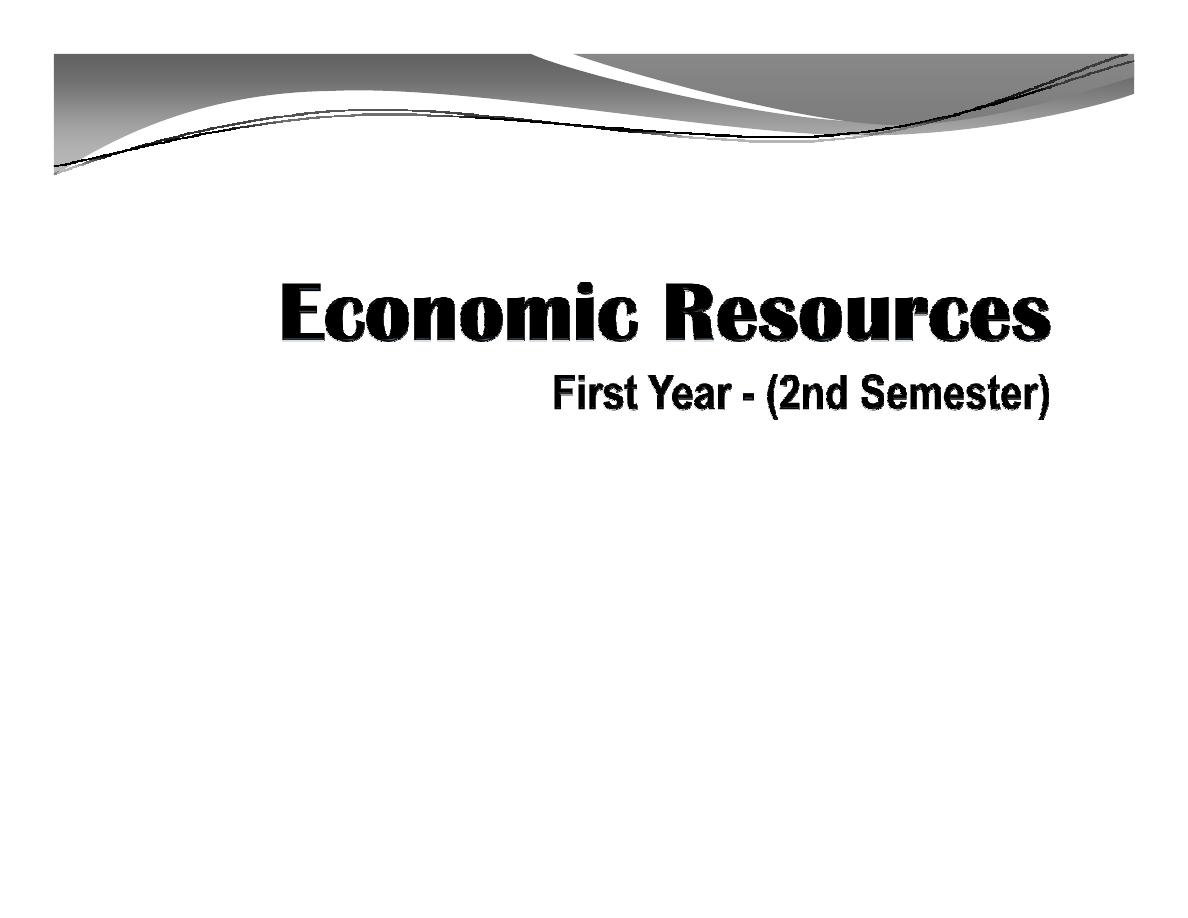
Dr/
Dr/ Hebatallah
Hebatallah ADAM
ADAM
Associate Professor of Economics
Faculty of Commerce Ain Shams University

Chapter 6
Fuel and Power Resources:
Fuel and Power Resources:
“Energy Economics”*
2
Dr/ Hebatallah ADAM - Economics Resources - 2015

I. Classification of Energy
a.
Primary and Secondary Forms of Energy
Primary energy: It is an energy source that is extracted from a
stock of natural resources or captured from a flow of resources
and that has not undergone any transformation or
conversion other than separation and cleaning. (Examples
include coal, crude oil, natural gas, solar power).
Secondary energy : It refers to any energy that is obtained from
a primary energy source employing a transformation or
conversion process. (Examples: oil products or electricity)
Dr/ Hebatallah ADAM - Economics Resources - 2015
3

I. Classification of Energy (cont'd)
b.
Renewable and Non-Renewable Forms of Energy
Non-renewable Energy: A non-renewable source of energy is
one where the primary energy comes from a finite stock of
resources. (For example, coal or crude oil).
resources. (For example, coal or crude oil).
Renewable energy: On the other hand, if any primary energy is
obtained from a constantly available flow of energy, the energy
is known as renewable energy. (For example, Solar energy, wind).
Dr/ Hebatallah ADAM - Economics Resources - 2015
4

I. Classification of Energy (cont'd)
c.
Commercial and Non-Commercial Energies
Commercial energies are those that are traded wholly or
almost entirely in the market place and therefore would
command a market price. (Examples include coal, oil, gas and
command a market price. (Examples include coal, oil, gas and
electricity).
Non-commercial energies are those which do not pass through
the market place and accordingly, do not have a market price.
(Common examples include energies collected by people for their
own use).
Dr/ Hebatallah ADAM - Economics Resources - 2015
5

I. Classification of Energy (cont'd)
d.
Conventional and Non-Conventional Energies
This classification is based on the technologies used to
capture energy sources.
Conventional energies are those which are obtained through
Conventional energies are those which are obtained through
commonly used technologies. (examples: Animal or Crop
residues (bio-energy))
Non-conventional energies are those obtained using new
and novel technologies or sources. (examples: Oil from oil
sands, Oil from coal or gas, Solar).
Dr/ Hebatallah ADAM - Economics Resources - 2015
6

II. Issues Facing Energy Resource-Poor Countries
1.
Managing Effects of Price Shocks: a variety of inter-linked
effects can then be expected
a)
Higher oil prices leads to a fall in oil demand.
b)
The cost of production of goods and services rises.
c)
Higher costs of goods and services put pressure on general price
c)
Higher costs of goods and services put pressure on general price
levels, increasing inflation.
d)
Higher costs and inflation, and lower profit margins would put
pressures on demand, wages and employment, affecting the
economic activities.
e)
Effects on economic activities influence financial markets,
interest rates and exchange rates.
Dr/ Hebatallah ADAM - Economics Resources - 2015
7

II. Issues Facing Energy Resource-Poor Countries
(cont'd)
2.
Energy Supply Security
Energy supply security is commonly defined as the ‘‘reliable and
adequate supply of energy at reasonable prices’’. Reliable and
adequate supply refers to uninterrupted supply of energy that
is able to meet the demand of the global community.
While developed countries participate in an emergency
response programme through the International Energy Agency
(IEA),
there is no such arrangement for the developing
countries.
Dr/ Hebatallah ADAM - Economics Resources - 2015
8

Thank You
Thank You
Dr/ Hebatallah ADAM - Economics Resources - 2015
9

* Reference:
Farag Ezzat & Hebatallah Adam, (2015),
“Economics
Resources”,
Ain
Shams
University, Faculty of Commerce, Part II -
University, Faculty of Commerce, Part II -
“Chapter 6: Fuel and Power Resources:
“Energy Economics”, pp. (48-104).
Dr/ Hebatallah ADAM - Economics Resources - 2015
10
